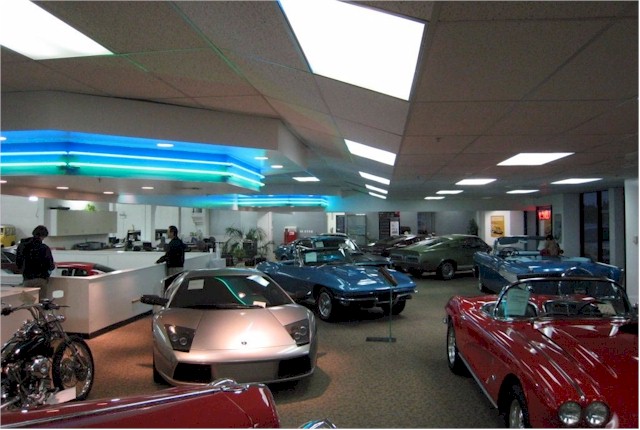2011 Mercedes SLS AMG: First Drive
The 2011 Mercedes SLS AMG is the first clean sheet design from AMG and the new flagship for the entire company. As a modern re-interpretation of the 300SL it's also a return to the fast, striking Mercedes of yore.
From the first moment you get into the SLS there's no escaping the improbably long nose. The nearest equivalent car I can think of that sits the driver so far from the front axle is the 2009 BMW Z4, but where that car's been described as a clown shoe, Pulitzer Prize-winning auto hack Dan Neil says the SLS looks like "a hairbrush." Unlike that car, the SLS is also wide (76 inches) so guiding it out of a parking lot is a daunting task, requiring placing the front wheels with guestimation versus vision. Open the hood and there's a good foot of clear space between the radiator and the airboxes mounted just in front of the engine. Good packaging this is not, but this long nose lends the understated super car the only visual drama it really has; the abbreviated cabin and low roof help to emphasize just what the big Merc is packing up front. The cabin is also further midship than it feels, with the relatively large 22-gallon tank sitting between the seats and the rear axle.
At speed, those awkward proportions cease to negatively impact the driving experience and the SLS actually manifests some steering feel, mostly felt over bumps and cat's eyes rather than in corners, but that's OK, because the car is heavily biased toward oversteer so it's only really the rear you need to feel. Actually, let's take a quick step back. The 9.5" wide front wheels wearing 265/35 low profiles and 11" rears with 295/30s don't really have an issue with grip. The problem is the 6.2-plus-change-liter (ignore the badges) V8 and its 571 HP just makes pushing the limits of what's possible way too easy.
Heavily modified over the standard AMG V8 that's in everything from the C63 to the S63, this M159 6.2-and-change (same capacity as all the other M156 engines) breathes much freer thanks to an all-new intake system, more aggressive valve timing, tubular steel headers and a de-throttled exhaust. It also switches to dry sump lubrication so the engine can be mounted lower in the chassis. In addition to that 571 HP at 6,800 RPM, it now develops 479 Lb-Ft of torque at 4,750 RPM, delivering the unique mix of high-revving power with low-RPM torque. That's also a healthy increase over the 525 HP the M156 normally develops and all it has to motivate is a 3,571 Lbs curb weight gull-winged bird of prey (703 Lbs lighter than the SL63 and 326 Lbs lighter than the SLR thanks to an aluminum chassis and body). Weight distribution is 47% front, 53% rear (unintuitive by look, but makes sense when you consider the aforementioned extra crumple zone space), aiding traction but still failing to overcome the fast-revving engine's ability to easily overcome the rear.
Driving an oversteer-biased car at a corner-biased track like Laguna Seca, like we did yesterday, is actually kind of refreshing. Where most cars would understeer into turn 2 and push the front around turn 11 and onto the back straight, the SLS is aggressively trying to step out the rear, even on a constant throttle. Credit for recovering the slides goes to the almost unbeatable stability control system. While you can push enough buttons to make it say "ESP-OFF", that doesn't fully shut down the system, with it still moderating acceleration-related wheelspin and re-engaging automatically the second you tap the brakes. While the SLS is a fast and engaging car even with all the nanny systems fully on, we of course mourn the loss of full driver control. My planned photo for the top of this review was a doors-up burnout, but sadly the car just wouldn't spin up the rear tires from a standstill.
That same system acts to control wheelspin on a hard launch, contributing to a manufacturer-reported 3.8-second 0-to-60 MPH time, eventually reaching a limited top speed of 197 MPH.
That engine also feels far more alive than in any other AMG application. It pops and burbles on the overrun and, mated to the seven speed dual clutch gearbox, is fast to rev and shift. It's also somewhat awkward in any of the three automatic modes, somehow always managing to be in the wrong gear, no matter the setting. The manual paddle shifter improves that, but compared to competitors, are a little slow to shift. Mercedes claims the transmission takes as little as 100 milliseconds to shift, but in practice it feels far slower, with a pronounced delay between a pull of the paddle and the transmission actually doing what you told it to.
I came into this drive expecting a luxury grand tourer that was also fast, but instead found a track-oriented super car that is also luxurious. On the road, the limitations of this incredibly fast car are relatively easy to reach, yet hard to live up to. It's also firmly sprung, always loud (both from road and engine noise) and fairly cramped. The SL63 would probably make an equally fast, yet more refined, spacious and comfortable road car, but the SLS would literally drive circles round that car on the track. Still, this combination of outright performance with extreme luxury is relatively rare. The 911 GT2 is harsh and edgy on the road, a 599 is way more expensive, as is the even-faster Lexus LFA. On the opposite end of the spectrum the Audi R8 does luxury a little better but track performance is a little less involving. At an estimate $200,000, the SLS carves a performance-oriented, luxury-capable niche all its own, something that's aided by the classy, restrained looks and the visual drama of the doors.







No comments:
Post a Comment
Note: Only a member of this blog may post a comment.